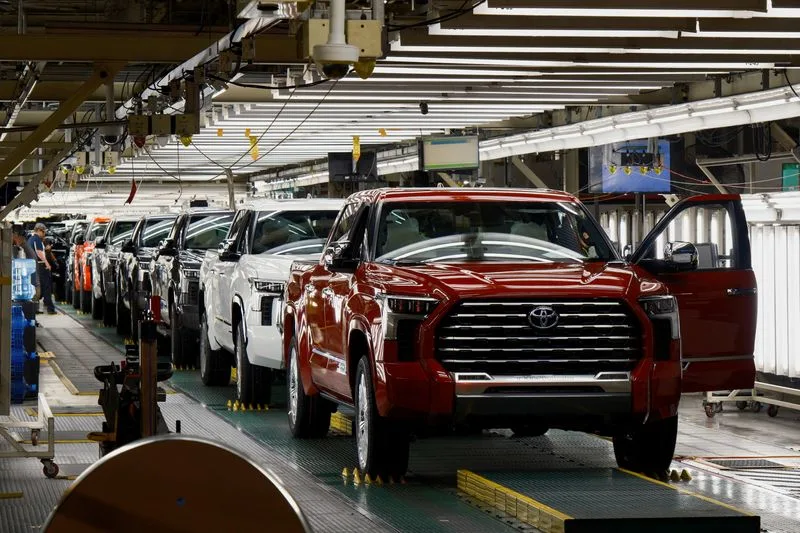
Toyota’s worldwide output drops for the eighth consecutive month, driven by declining sales and production issues in the U.S. and China. This article explores the factors behind Toyota’s performance and the challenges ahead.
Toyota’s worldwide output drops for the eighth consecutive month, signaling ongoing challenges for the automaker in key markets. In September, Toyota reported an 8% decline in global production compared to the same month last year, totaling 826,556 vehicles. This downturn is attributed to falling sales and production issues in the United States and China, the company’s largest markets.
U.S. and China Markets Drive Toyota’s Worldwide Output Drops
The decline in Toyota’s output is significantly influenced by the company’s performance in the U.S. and Chinese markets. In the U.S., production fell by 14% due to a temporary suspension of the Grand Highlander and Lexus TX SUVs caused by an airbag issue. This production halt not only affected output but also delayed vehicle deliveries to consumers, resulting in lost sales opportunities. Meanwhile, in China, competition from electric vehicle (EV) manufacturers has intensified, resulting in a 19% drop in production as consumers increasingly gravitate toward locally produced EVs and plug-in hybrids. The transition to electric mobility is reshaping the automotive landscape, and Toyota’s traditional models are feeling the impact.
September Production and Sales Figures for Toyota’s Worldwide Output Drops
Toyota’s global sales also reflected this downward trend, with a 7% decrease in September, totaling 853,149 vehicles. Notably, U.S. sales plummeted by 20%, while sales in China and Japan fell by 9% and 6%, respectively. The decline in sales can be attributed not only to production issues but also to shifts in consumer preferences, as buyers increasingly seek environmentally friendly options. Over the first nine months of the year, Toyota has sold 7.4 million vehicles, marking a 2% year-on-year decrease.
Suspension of Key Models Contributes to Toyota’s Worldwide Output Drops
The production of the Grand Highlander and Lexus TX SUVs was suspended earlier this year due to safety concerns related to airbag systems. Although production resumed on October 21, the suspension has negatively impacted Toyota’s overall output in the U.S., further contributing to the decline in sales figures. These challenges highlight the vulnerabilities in Toyota’s supply chain and the need for stringent quality control measures to avoid similar issues in the future.
Electric Vehicle Competition Puts Pressure on Toyota’s Worldwide Output Drops
As the shift toward electric vehicles continues, Toyota faces significant competition from Chinese brands that offer more affordable and innovative EVs and hybrids. This transition is challenging for Toyota, which has historically focused on hybrids rather than fully electric vehicles. The pressure to adapt to changing consumer preferences is palpable as the market dynamics evolve. Companies like NIO and BYD are rapidly capturing market share, compelling Toyota to accelerate its EV development initiatives. The automaker has announced plans to introduce a series of electric models in the coming years, but the transition will require careful execution and consumer engagement.
Navigating Production and Market Challenges Amid Toyota’s Worldwide Output Drops
Looking ahead, Toyota must navigate these challenges to restore its production levels. The company’s commitment to electrification and innovation will be crucial in regaining market share in both the U.S. and China. Addressing production issues and enhancing the appeal of its EV lineup may determine the automaker’s success in the coming months. Furthermore, the economic landscape, including inflation and supply chain disruptions, continues to pose risks that could impact Toyota’s operations.
Understanding Consumer Trends Amid Toyota’s Worldwide Output Drops
To successfully navigate these challenges, Toyota must closely monitor consumer trends and preferences. As more consumers prioritize sustainability, investing in eco-friendly vehicles will be critical. The automaker must enhance its marketing strategies to emphasize its commitment to environmental responsibility and innovation in the EV space.
8. Conclusion: The Road Ahead for Toyota
Toyota’s Worldwide Output Drops: Continued Struggles in a Competitive Landscape
In conclusion, Toyota’s worldwide output drops reflect broader market challenges and increased competition. The company’s ability to adapt and innovate will be essential in overcoming these hurdles and positioning itself for future growth. With strategic planning and a focus on consumer needs, Toyota can turn its current challenges into opportunities for renewal and success in the evolving automotive market.